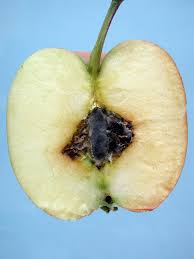What is fungal disease?
Fungi constitute the largest number of plant pathogens and are responsible for a range of serious plant diseases. They damage plants by killing cells and/or causing plant stress. Sources of fungal infections are infected seed, soil, crop debris, nearby crops and weeds.
Disease fungi take their energy from the plants on which they live. They are responsible for a great deal of damage and are characterized by wilting, scabs, moldy coatings, rusts, blotches and rotted tissue.
Major fungal disease of apple :-
The various fungal disease of apple are as follow :-
- COMMON NAME SCIENTIFIC NAME
- Anthracnose canker Cryptosporiopsis curvispora
- Apple scab Venturia inaequalis
- Black root rot Xylaria polymorpha
- Blue mold Penicillium expansum
- Diaporthe canker Phomopsis tanakae
- Powdery mildew Podosphora leucotricha
- Side rot Phialophora malorum
1. Anthracnose canker
Infection from the anthracanose fungus apppea in the fall as small circular reddish or purple spots that become elliptical and sunken the following spring. The disease causes serious losses tio young shoot, flower and fruit. mainly it attack on the fruits. It also affects fruits during storage. It attack plants in the spring when the weather is cool and wet, primarily on leaves and twigs. The fungi overwinter in dead twigs and fallen leaves. Cool, rainy weather creates perfect conditions for the spores to spread.
Signs of identifying disease
- low fruit yield
- fruit fall
- flower dried and fall over
- chlorotic leaves
- stunted growth
- limb dieback from tips
2. Apple scab
lesiondeveloped on the both side of leaves, usually developing on the lower side. Leaves that are heavily infected with scab will curl, shrivel and fall from the tree. The favourable condition of the apple scab is april to july because of the highly fluctuation in temperature i.e some time their is rain and some time is hot and vice versa . in this fluctutation temp it will grow fastely.
Sign of apple scab:-
- twisted and puckered leaves that have black,
- circular scabby spots on the underside
- the upper surface the spots look velvety and have an olive-green,
- As they age, leaf spots turn dark brown to black.
- leaf become dried and fall out
- appear brown spot on the fruits
3. Black root rot
Black root rot is also called ded man's fingers or Xylaris root rot,is occasionally oberserved on mature apple and cherry trees. Although tress of al ages can be infected, most trees that die from black root rot are at least 10 year old. Black root rot is caused by two species of the fungus. Cankers often remain small and superficial but sometimes enlarge up to 50 cm in length along the infected limb, killing and cracking the bark.the lesion eventually enlarges into a light or tan brown rot with concentric dark and light ring.
Sign of black root rot
- light brown patches at leaf margin.
- leaf become dried and fall .
- dark black lesion occure on the fruit.
- spread from one tissue to the other tissue.
- stunted growth of fruit and leaves.
4. Blue mold
The lesion may be covered by bluish-green spores that intially are bnearly snow white in colour. In cold storage lesion expand 2.5-3.8 cm in diameter after 8-10 weeks after infection. Blue mold is the post harvest disease and most important disease all over the world.
Sign
- dark brown lesion are appear in the fruit
- this disease spread mainly in the storage
- the foul smell in the fruit starts
- lower yield
5. Powdery mildew
White powdery spores develop mostly on the upper leaf surface. Young leaves turn pale whitish - grey- green. The ends of mildewed leaves can twist and curl upward. Leaves become narrow, brittle, curled and covered with a white powdery layer. Flowers might be stunted and fail to develop.
Sign
- powdery mildew may be found on buds, blossoms, leaves, twigs, and fruit.
- Stunt the growth of tress.
- white powdery spore are formed on upper leaf surface.
- leaves become dry.
- lower yield.
- also affect the storage of the apple.
6. Side rot
Side rot occurs only on fruit. Cankers can form on twigs, but they are rare. The fungus is one of the few fruit rot organisms that can penetrate the unbroken skin of the fruit. Maturity of the fruit, temperature, humidity, and presence of disease are factors that determine when the disease manifests. Soft rot typically manifests in July and August and fruit susceptibility increases as it begins to mature.
Sign
- Rot begins on the tuber surface and progresses inward.
- Symptoms of soft rot include soft, wet, rotted, tan or cream-colored tissues.
- Shallow necrotic spots on the tubers result from infections through lenticels.
- rust appearance in the fruit
- lower yield
- The foul smell in fruit start.
Must visit 👇👇👇











No comments:
Post a Comment